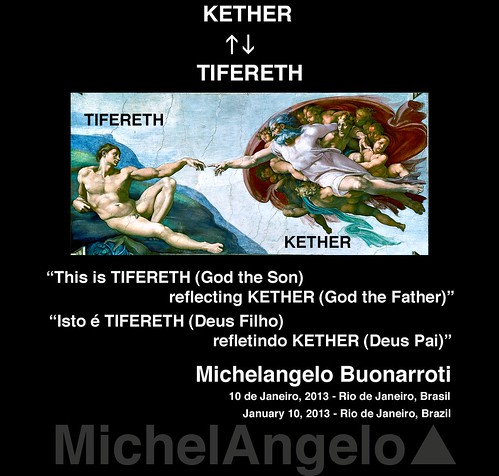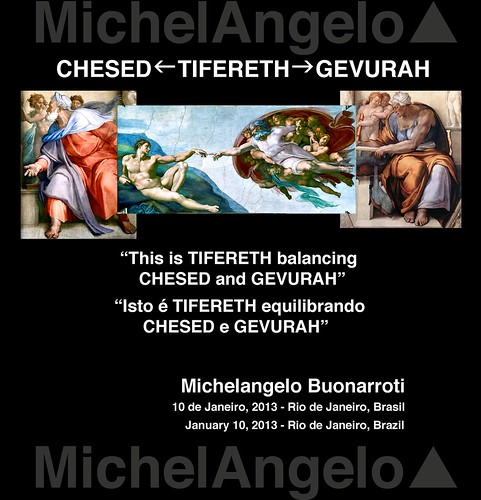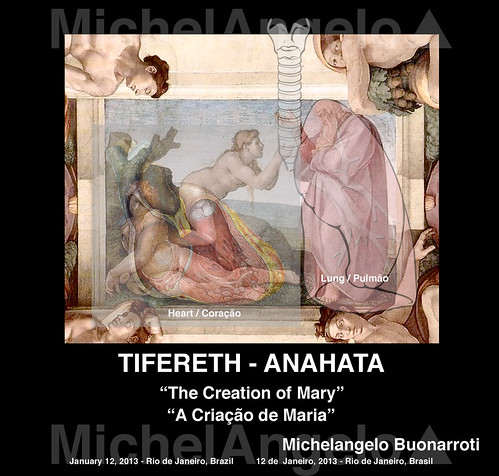This is the center of Tifereth / Este é o centro de Tifereth.
Tifereth:
en.wikipedia.org/wiki/Tiferet
Anahata:
en.wikipedia.org/wiki/Anahata
English:
Tifereth The Daughter
Let me be very clear about what I actually did on the Sistine Ceiling. As I said before, there is No "Creation Of Adam", therefore there is NO "Creation of Eve" either. Althought I agree that, in this case, my intention is hidden on the clear understanding of the scene (the reference used is a famous work from other artist), things are not what they appear to be on the Ceiling.
The male sleeping figure is NOT Adam. He is just the part of a heart also represented with rocks and cut tree trunks. The male standing figure is NOT God as well. Notice that God's main image is a mantle. That was the way I chose to outline a lung. So… the female awakening figure is NOT Eve. She is a divine emanation coming from the heart. She is a divine emanation in woman form linked to the heart. She is the pair of "Tifereth, The Son". She is "Tifereth, The Daughter".
Why "Tifereth, The Daughter"? Because she's actually The Virgin Mary. She is the point where the transcendental salvation starts to take form. She is the point where Kether starts to become cognizable. The Sistine Ceiling is about the evolution of the concept of salvation and the understanding of its transcendence.
The human life all over the Sistine Ceiling is represented in pairs of man and woman. The visualization of the Kabbalah organized by myself had the intention to highlight MY understanding of salvation: the process of reincarnation.
But I had a secret plan behind all the visual narrative: I designed a hidden visual message, with intimate references, to be recognized only by myself in the case of my own return to Earth, reincarnated in a future life. My main concern about sending a message to my future self was to imagine what kind of information would survive the centuries to come. One topic that I considered first was the story of the Sistine Chapel itself. The Chapel was build and dedicated to the Assumption of Mary, therefore I decided to paint my "Creation of Eve" on the center of the Sistine Ceiling. No matter what explanations others may have, the true meaning of the painting could only be discovered if you put the scene into the correct sequence for its understanding.
Português:
Tifereth A Filha
Deixem-me ser claro sobre o que eu realmente fiz no teto da Capela Sistina. Como disse antes, não existe nenhuma "Criação de Adão", portanto NÃO há "Criação de Eva" também. Concordo que, neste caso, a minha intenção está bem escondida na compreensão aparentemente clara da cena (a referência utilizada é uma famosa obra de outro artista), mas as coisas não são exatamente o que parecem ser.
A figura masculina dormindo não é Adão! É apenas a parte de um coração também representado com pedras e troncos de árvores cortadas. A figura masculina de pé também NÃO é Deus! Observe que "Sua" imagem principal é um manto. O uso do manto foi a maneira que encontrei para delinear um pulmão. Então... é óbvio que a figura feminina não é Eva. Ela é uma emanação divina proveniente do coração. Ela é uma emanação divina em forma de mulher ligada ao coração. Ela é o par de Tifereth, O Filho. Ela é Tifereth, A Filha.
Por que Tifereth, A Filha? Porque ela, na verdade, é a Virgem Maria. Ele é o ponto onde a salvação transcendente começa a tomar forma. Ela é o ponto onde Kether começa a se tornar cognoscível. O Teto da Sistina é sobre a evolução da concepção de salvação e a compreensão de sua transcendência.
A vida humana por todo o Teto da Capela Sistina está representada em pares de homem e mulher. A visualização da Cabala organizada por mim teve a intenção de destacar a minha compreensão da salvação: o processo de reencarnação.
Contudo, eu tinha um plano secreto por trás da narrativa visual: a organização de uma bem escondida mensagem visual, repleta de referências íntimas, que só poderia ser reconhecida por mim mesmo, no caso do meu próprio retorno à Terra, reencarnado em uma vida futura. A minha maior preocupação sobre o envio de uma mensagem para o meu futuro eu era imaginar que tipo de informação poderia sobreviver aos séculos por vir. Um tópico que considerei primeiro foi a história da própria Capela Sistina. A Capela foi construída e dedicada à Assunção de Maria, e por isso decidi pintar a "Criação de Eva" no centro do Teto da Capela Sistina. Não importa que explicações outros possam ter, o verdadeiro significado da "Criação de Eva" só pode ser descoberto se você colocar a cena dentro da sequência correta para compreendê-la.













